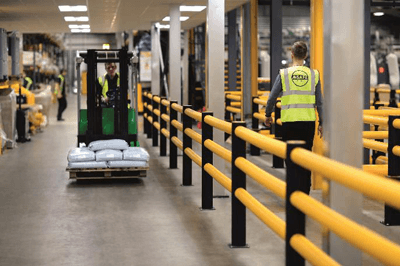What Is a Guardrail?
 A guardrail is a protective barrier used in factories and other industrial settings to prevent or mitigate damage from vehicle collisions. With the frequent operation of forklifts, AGVs, and other vehicles, guardrails play a crucial role in averting industrial accidents and preserving the safety of workers and equipment.
A guardrail is a protective barrier used in factories and other industrial settings to prevent or mitigate damage from vehicle collisions. With the frequent operation of forklifts, AGVs, and other vehicles, guardrails play a crucial role in averting industrial accidents and preserving the safety of workers and equipment.
While traditional safety measures focused on human-centered approaches like training and rule compliance, the adoption of guardrails as physical barriers is increasingly recognized as essential. They are key to ensuring the separation of pedestrians and vehicles in workplaces.
Uses of Guardrails
Guardrails serve two primary purposes:
1. To Protect People
Guardrails are installed to physically separate pedestrian zones from vehicle-operating areas, enhancing safety in factories where both coexist.
2. Protecting Assets
They are also employed to safeguard production equipment, transport equipment, and infrastructure like buildings, shutters, and piping against vehicle collisions.
Types of Guardrails
Guardrails at manufacturing sites come in various types, each suited to specific operational environments:
1. Simple Barrier
Simple barriers are floor-installed and act mainly as visual warnings. They are used both temporarily and permanently but don’t offer significant impact resistance.
2. Steel Barriers
Steel barriers provide a moderate level of protection but tend to deform upon impact and may damage concrete floors due to lack of shock absorption.
3. Polymer Protective Barriers
These modern barriers are made of polymer resin, known for their impact absorption and recovery properties. They offer advanced protection without the drawbacks of rusting or paint peeling and don’t damage the floor upon impact. Choosing a barrier rated for the specific impact level needed for the work environment ensures appropriate protection.